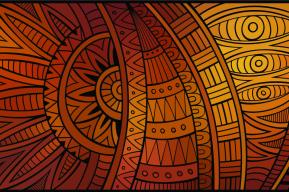Article
The strange vicissitudes of Leonardo's manuscripts

For almost three centuries, Leonardo da Vinci's mass of scientific jottings and sketches languished in obscurity. They were buried in notebooks and scribbling pads which were chaotically disorganized and hard to read. That is why, until the end of the 18th century, Leonardo's fame as an artist far surpassed his reputation as a scientist and engineer. Then too, after Leonardo's death in 1519, his manuscripts were first neglected and later split up and dispersed. Many of them disappeared forever. But in the 20th century, modern scholars and restorers have done much to repair the havoc wreaked on Leonardo's manuscripts and we can now appreciate more fully the activity of one of the most powerful and universal minds the world has ever known.
By Paolo Galluzzi
In his will Leonardo left all his manuscripts to his faithful pupil Francesco Melzi, who had accompanied him on his travels and was present at his death-bed. Melzi transferred his precious inheritance to his villa at Vaprio d'Adda near Milan. After Francesco's death in 1570, his son and heir, Orazio, failed to see the significance of the Leonardo material and simply dumped it in the attic.
Thus it was an easy matter for Lelio Gavardi, the tutor in the Melzi household, to get his hands on thirteen Leonardo manuscripts. Gavardi went off to Florence with his prize, hoping to sell it for a high price to Duke Francesco de Medicis. However, incredible though it may seem, one of the Duke's counsellors advised his master that "These are not things for Your Excellency to bother with," and the sale did not go through.
Gavardi now abandoned his idea of selling the manuscripts and asked his friend Ambrogio Mazzenta, who was about to leave for Milan, to take them back to Orazio Melzi. However, Orazio did not want them and (according to the account in Mazzenta's memoirs) "was amazed that I had gone to all this trouble and made me a present of the manuscripts."
At this point, Pompeo Leoni of Arezzo comes on to the scene, and his role in the strange story of Leonardo's manuscripts is extremely important. Leoni, court sculptor to Philip II of Spain, showed great interest in the Leonardo manuscripts preserved by Francesco Melzi's heirs and managed to acquire many of them in exchange for promises of personal favours and protection. Leoni also got hold of ten of the thirteen notebooks given to Mazzenta by Orazio Melzi. Thus, in the eight years between 1582 and 1590, almost all Leonardo's papers passed to a new owner.
Leoni wanted to present the documents in a more attractive package, and therefore decided to split up several of the notebooks and rearrange them into large codices. But he was totally incompetent for this kind of work, and the net effect of his bizarre attempt at "restoration" was to alter the whole arrangement of Leonardo's papers and to destroy vital evidence as to when they were composed, in what order, the original number of notebooks, and so on. He also paved the way for a new Odyssey of loss and dispersion.
There is no evidence that Leoni carried out the intention which he expressed to Orazio Melzi of handing the Leonardo material over to Philip II of Spain as a gift. It appears that he only gave a sample of the documents to his royal patron and kept the rest for himself, since many of the manuscripts came into the hands of Polidoro Caichi, Leoni's son-in-law and heir, who put them up for sale.
Around 1622 Caichi sold the large volume compiled by Leoni and now known as the Codex Atlanticus to Count Galeazzo Arconati of Milan, and in 1636 Arconati gave this Codex (together with other Leonardo manuscripts) to the Ambrosian Library in Milan.
Other Leonardo documents which had been in Leoni's possession ended up in England. Thomas Howard, earl of Arundel, managed to acquire the second large volume of Leonardo papers compiled by Leoni. This is the collection of drawings now known as the Windsor Collection, since it is housed in the Royal Library, Windsor. Another manuscript (the present Codex Arundel 263) was also acquired by Thomas Howard and subsequently given by one of his heirs to the Royal Society. The earl of Arundel's acquisitions date from 1630-1640.
In the 18th century new "movements" of Leonardo manuscripts took place. Around 1715 Lord Leicester acquired and took back to England the Codex which now bears his name. Another manuscript, the so-called Codex Trivulzianus (notable for the long lists of words recorded in it by Leonardo) was back in the Ambrosian Library around the year 1750 Arconati had donated it to the Library and later removed it.
At the end of the 18th century even those notebooks which seemed to have found a permanent home started to move around again. During the Italian campaign in 1796-1797, Napoleon was ordered by the French government of that time, the Directory, to confiscate Italian art treasures and send them to Paris. The Codex Atlanticus and the manuscripts housed in the Ambrosian Library were among the major works which thus found their way to the French capital.
The Codex Atlanticus was deposited in the Bibliothèque Nationale, and the manuscript material was handed over to the Institut de France. Then at the end of the Napoleonic Wars the foreign governments involved managed to obtain the restitution of many of the art treasures which had been removed from their countries. The Codex Atlanticus was returned to Milan, but the Institut de France held on to the other Leonardo manuscripts.
In the 19th century English libraries enjoyed a new influx of Leonardo documents. In 1876, for example, John Forster gave the South Kensington Museum (now the Victoria and Albert Museum) the three Leonardo notebooks which are today known as the Forster Codices. However, after this generous gesture another extremely alarming episode occurred. Count Guglielmo Libri, a bibliophile and a pioneer of modern scientific historiography, became interested in Leonardo, and even thought of bringing out an edition of Leonardo's unpublished writings.
However, Count Libri could not resist the temptation of removing a number of leaves from the Leonardo notebooks which he studied at the Institut de France. Libri was a sharp businessman and he set about selling the manuscripts he had appropriated.
Some of the stolen manuscript pages found their way to England, while the small Codex on The Flight of Birds was purchased for 4,000 lire by a certain Count Manzoni, who later sold it to an eminent Leonardo scholar, Theodore Sabachnikoff. Meanwhile, the directors of the Institut de France became suspicious of Libri, the only person who had been in a position to consult the Paris manuscripts. Libri denied the theft energetically, but the evidence against him was overwhelming, and he was sentenced (in his absence) to ten years' imprisonment. After this scandal, the Leonardo pages that had illegally crossed to England were returned to the Institut de France, and Sabachnikoff handed over The Flight of Birds Codex to the Biblioteca Reale in Turin, where it still is today.
The story of the main changes of ownership of the Leonardo notebooks might have ended there. However, at the beginning of 1967 came official news of an astonishing find : two Leonardo notebooks previously considered lost had been discovered in the Madrid National Library.
After an initial reaction of justified amazement, people began to ask how these two manuscripts could have turned up in Madrid. Scholars have come up with the following answer. Some of the Leonardo material owned by Pompeo Leoni was sold in Spain after his death. One of the purchasers was probably Juan de Espina, a Madrid collector. Between 1620 and 1630 first the future Charles I of England (then the Prince of Wales) and later the Florentine Vincenzo Carducci visited de Espina and saw his collection. Both visitors were particularly impressed by two books "written and drawn by the great Leonardo da Vinci."
When de Espina died in 1642, he left his precious collection to the King of Spain. The legacy included the two Leonardo books, and these were then deposited in the Palace Library, which around 1830 became the nucleus of Spain's recently founded National Library. It is highly likely that the two recently discovered notebooks are the two manuscripts which once belonged to de Espina.
In a nineteenth-century printed catalogue of the Madrid National Library, there is a reference to two Leonardo "autographs". However, everyone who followed up this reference and asked to consult the precious manuscripts was disappointed. Other manuscripts were found at the shelf-marks given in the catalogue, and there was no sign of the Leonardo autographs.
At the end of the 19th century, a Florentine bibliophile named Tammazo de Marins tried to find the manuscripts in the Madrid Library, but he was unsuccessful and the Library's directors decided to consider the two volumes as definitely lost.
Then, in 1964, an eminent French Leonardo scholar, André Corbeau, expressed his conviction that the two manuscripts were in fact in the National Library and that their failure to come to light might well be due to an error in the printed catalogue. At this point the Library's directors decided to make another attempt to locate the two notebooks.
This time the search was successful. At the beginning of 1965, Don Ramon Paz y Remolar, the director of the manuscript section of the Library, had the immense surprise of finding the Leonardo volumes, not at the shelfmarks given in the nineteenth-century catalogue (Aa 19 and 20), but at shelfmarks Aa 119 and 120.
The news of this important discovery spread by word of mouth through the world of scholarship. In 1967 the news was officially confirmed, and today the massive contribution to our knowledge of Leonardo's work provided by these new manuscripts is at last being made available to the public in a facsimile edition to be published this autumn by McGraw-Hill Book Company of Codex Madrid /and Codex Madrid II, as they are now called.
Another event of the last few years which can be compared without excessive exaggeration to the discovery of a new manuscript is the restoration of the Codex Atlanticus belonging to the Ambrosian Library in Milan.
The man behind this great project was Cardinal Montlni, Archbishop of Milan, now Pope Paul VI. In 1962 he successfully urged the directors of the Ambrosian Library to send the precious Codex to be restored at the Convent of Grottaferrata near Rome. The idea was not only to conserve the Codex Atlanticus, but to salvage as much as possible from the disastrous scissorsand-paste job carried out by its compiler, Leoni, who had arbitrarily gathered together whatever he thought related to mechanics in the Leonardo papers and notebooks belonging to him.
Leoni had taken large sheets of thick white paper (the size used for atlases, hence the title Codex Atlanticus), and used them as a backing on which to "stick" the original pages by Leonardo, which were considerably smaller and often covered from top to bottom with sketches and writing. Some of Leonardo's pages were covered with drawing and writing on just one side of the paper. In these cases, or whenever Leoni considered the handful of notes and hurried sketches on the verso of the paper to be unimportant, he stuck the verso directly on to the backing page.
When, however, Leonardo had covered both sides of the paper with notations and drawings, Leoni made a kind of window in the backing page so that both recto and verso were visible. Finally, when dealing with large-sized Leonardo pages, Leoni adopted yet another system : he folded the page in two, introduced a window in the backing page on which he mounted one of the two halves, and left the other half of the Leonardo page hanging folded just as it was.
Leoni's barbaric treatment of the manuscripts had unfortunate results. A large number of verso sides on which Leonardo had recorded his thoughts are lost. The margins of the pages which have been pasted on to "windows" are also lost, and these often contained parts of a drawing or the continuation of writing. Thirdly, in the case of the large pages folded in two, the part left hanging has often been torn off and consequently has disappeared.
The restoration carried out during ten years of devoted work at Grottaferrata has entirely altered the appearance of the Codex Atlanticus. In many ways it is now a completely new document. The restorers used the most advanced techniques. For example, the Leonardo originals were scrupulously washed and toughened with sophisticated modern fibres and chemicals in order to make them more resistant to the ravages of time.
Today, as a result of this great enterprise, the Codex Atlanticus consists of 1,068 pages, divided into twelve leather-bound volumes.
There was no question of letting the newly-restored Codex be used for consultation, and so a facsimile edition of it is being produced by the Florence publishing house of Barbera. The first volumes, the end-product of refined technology and painstaking collation with the original, have already been published, and the Commissione Nazionale Vinciana is at present preparing more transcriptions of the Codex, which will thus soon be available to Leonardo scholars in its entirety.
Thus modern scholars and restorers have done much to repair the havoc wreaked on Leonardo's manuscripts and we can now appreciate more fully the activity of one of the most powerful and universal minds the world has ever known.
Share
About the authors
Director of the Leonardo Museum and Library at Vinci, west of Florence, Paolo Galluzzi is currently preparing for Italy's National Research Council a dictionary of Galileo's philosophical and scientific terminology. He has written many studies on the history of Italian scientific thought in the 16th and 17th centuries.







